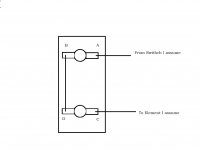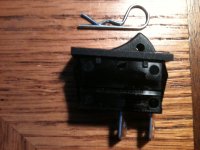I did get out to check ours out. Had 120 Volts to the water heater. Checked the connection going to the junction box. Was that ever a daunting task. With all the spaghetti from the UDC! Is there a way to tell if the WH is getting 120 Volts from outside? I then checked Ohms across the electrode and it was something like 10. so I am assuming it is the electrode. Will have to see if Suburban will send me one since I am in Warranty. Do I need to drain the water to change it out? And what size socket is that?
10 ohms across the electrode may not be a failure. See below.
General WH Diagnostic for No Hot Water
Note: Check System with Power on Unless Checking Individual Components
with an Ohmmeter
Check the circuit breaker to make sure it is not tripped. If tripped (possibly by low-voltage
condition or overloading), reset breaker and test.
Check for voltage at the on/off switch, and that the switch is functional. If voltage is
present at the input of the switch but not at the output when turned on, replace the switch.
An alternative test is to shut off power to the system, disconnect wires to the switch and
check with an ohmmeter. With the switch on, lack of continuity indicates a bad switch; continuity
indicates a properly working switch.
Check for voltage input to the thermostat/E.C.O. switch assembly. Verify voltage is at
all terminals. Check to make sure that the E.C.O. has not tripped, in which case the button
can be pushed to reset it. However, if this condition has occurred, the thermostat must be
tested to make sure it has not failed and the water heater is now cycling on the E.C.O.
switch. If voltage stops at any terminal and the water is not hot, replace the assembly.
An alternative test is to shut off power to water heater and disconnect wires to the thermostat/
E.C.O. assembly. Test for continuity from the input terminal to each of the other terminals.
An open indicates which component is bad. If there is continuity, and the thermostat is not
satisfied the component is in proper working order.
Check for voltage at the heating element. If voltage is present at the heating element,
but there is no amp draw on the heating element, replace the heating element.
The heating element can also be checked with an ohmmeter with the wires disconnected. A resistance
reading that can be computed using Ohms and Watts law will determine proper resistance.
The heating element should read approximately 14 - 17 Ohms (remember that the voltage
and wattage are printed on the heating element case). No resistance indicates an open element,
while continuity with no resistance indicates a shorted element which would also be
indicated by constant tripping of the circuit breaker.



